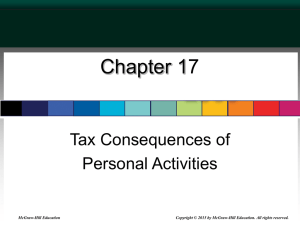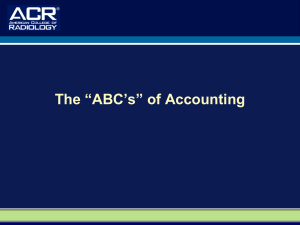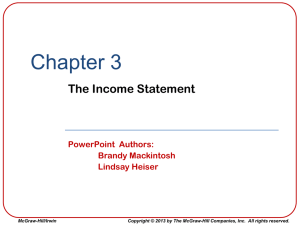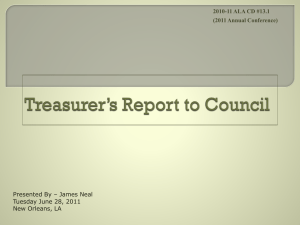T14F-Chp-06-1-Business-Expenses-2013
advertisement
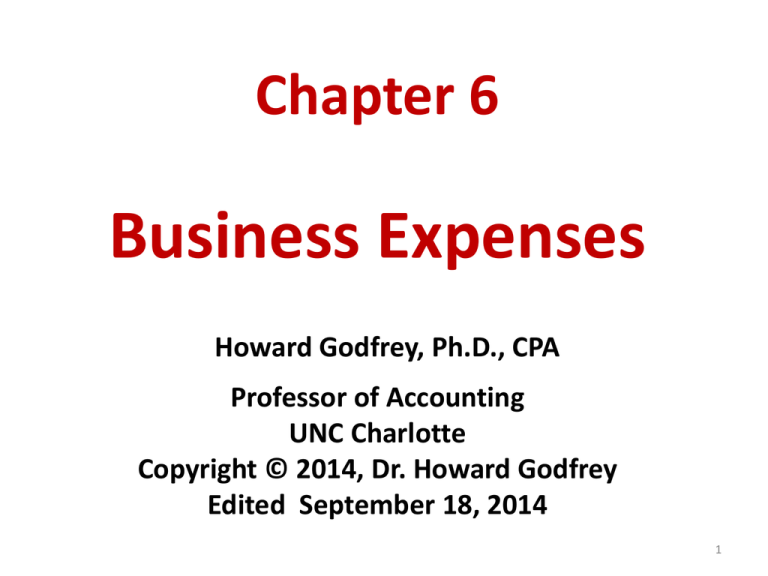
Chapter 6
Business Expenses
Howard Godfrey, Ph.D., CPA
Professor of Accounting
UNC Charlotte
Copyright © 2014, Dr. Howard Godfrey
Edited September 18, 2014
1
Business Expenses
Part 1. Introduction
Part 2. Business Expenses, Meals and
Entertainment, Auto,Travel, Gifts,
Education expense
Part 3. Compensation, Bad debts,
Qualified production activity expenses,
Insurance, Taxes, Legal fees.
Part 4. Deductions for AGIReimbursed exp. [accountable plans]
Deductions of self employed persons,
IRAs, [also Roth] Coverdale,
Higher education expenses,
Student loan expenses, Moving Expenses
2
Business Expenses
Meals & Ent.
Ded. for AGI
Auto Expense
Reimb. Expense
Travel
Self-Employment
Education
Retirement Cont.
Compensation Education Exp.
Bad Debts
Education Loans
Prod. Activities Moving Expense
Insurance, other Summary
3
General Tax Formula
Gross Income
Deductions For A.G.I.
Adjusted Gross Income (AGI)
Exemptions
(7,900)
Form 1040-Schedule A
Regular Item. Deductions
(13,100)
Misc. Item. Ded.
5,000
Less 2% of AGI
(2,000)
Deductible Amount
3,000
Total Deductions From AGI
Taxable Income
$110,000
(10,000)
100,000
(18,000)
$ 82,000
4
Ent., Auto, Travel, Gift, Ed.
Meals & entertainment
Auto Expense
Travel Expense
Education Expenses
5
Meals & Entertainment.
• The deduction for business meals
and entertainment expenses is
limited to 50% of the qualified
expenses
• The 50% limit is imposed on
whoever (employer or employee)
ultimately pays the expense
Transportation Expenses.
• Certain transportation expenses incurred
when the taxpayer is not away from home
are deductible and include
–the cost of transportation from one work
location to another
–transportation between home and a
temporary work location if the taxpayer
has a regular place of business
–any meal costs are not deductible,
however
Transportation Expenses
• The prorated business portion of
actual auto expenses or a standard
mileage rate (56¢ for 2014) plus
related parking and tolls can be
deducted
• Commuting expenses (between home
and regular place of business) are a
personal nondeductible expense
Documentation
Expenses related to Meals, Entertainment,
Automobile Usage, Travel, and Business
Gifts are deductible subject to limitations
and strict documentation requirements
–Amount
–Time and place
–Date and description
–Business purpose
–Business relationship of other person(s)
Auto Expense
TP uses auto 100% for bus.
Depreciation
$4,900
Gas, oil, repairs
$2,000
Parking and Tolls
$1,000
Business miles
15,000
Mileage Rate
Auto expense ded.?
TP uses auto 100% for bus.
Depreciation
$4,900
Gas, oil, repairs
$2,000
Parking and Tolls
$1,000
Business miles
15,000
Mileage Rate
$0.56
Mileage expense
$8,400
Parking and Tolls
$1,000
Total Deduction
$9,400
Travel Away From Home
• Travel expenses incurred for temporary
travel away from home on business are
deductible.
• Qualifying expenses include lodging, 50% of
meals, transportation to destination and
back, and incidental expenses
–Away from home refers to person’s tax
home; that is, the location of principal
place of employment regardless of where
the family residence is maintained
Temporary Assignments
• Temporary is defined as one year or less
• Employment away from home in a single
location that is realistically expected to
last (and does in fact last) for one year or
less, will be treated as temporary
• Assignment for more than one year shifts
tax home to the new location (no
deduction for travel and living costs)
Combining Business with Pleasure Travel
• Over 50% of the activity requiring
travel must have a business purpose
–Personal activity costs on a business trip
are not deductible
–Incidental business expenses on a
personal trip are deductible
–Travel for general educational purposes
or for investment related meetings is
not deductible
Combining Business with Pleasure Travel
• For U.S. travel, if the trip is primarily for
business, all transportation costs to and
from destination are deductible
• If primary purpose is pleasure, no
deduction for transportation
• Primary purpose is determined by the
number of days on business versus
personal days
Business Travel Expense
Juan went to Atlanta for 7 days.
Round trip airfare
Total
$475
Days Cost
4
Days-business
Days-pleasure
3
Hotel at daily rate
7
$175 1,225
Meals per day
7
$40
280
Incidentals
7
$25
175
Total Cost
$2,155
Total Deduction
Business Travel Expense
Juan went to Atlanta-7 days.
Total Deduct
$475
$475
Round trip airfare
Days Cost
Days-business
4
Days-pleasure
3
Hotel daily rate
7
$175
1,225
Meals per day
7
$40
280
Incidentals
7
175
$25
Total Cost
$2,155
Total Deduction
700
80
100
$1,355
Combining Business with Pleasure Travel
Meals & lodging are deductible only for days
on which business is conducted
• If a taxpayer remains in a temporary
location to reduce costs as a result of
– reduced airfare for Saturday night stays or
– for business conducted on both Friday and
Monday
– the costs for additional days are deductible if
they are less than the cost of returning home
when business is completed
Travel Expenses- Martha
Martha lives with her husband in Los
Angeles but works in San Diego. During the
week she stays in a hotel in San Diego and
eats in restaurants. On weekends she flies
home to Los Angeles. During the year,
Martha spent $5,000 for the hotel, and
$2,000 for meals while in San Diego. Her
airfare for travel between San Diego and Los
Angeles was $2,500. What is Martha’s
deduction for travel expenses?
Travel Expenses-Martha
Martha cannot deduct any
travel expenses.
Her tax home is in San Diego.
Her travel to Los Angeles is
purely personal and her
expenses are nondeductible.
Transportation Expense-John
John is a high school teacher. He travels three
days per week to a school in the next county
to work with gifted children in an afterschool program that does not end until 6:30
P.M.
He normally eats dinner before driving home.
If he drives 75 miles each way on 90 days to
the gifted program, his meal expense is $900,
and he maintains adequate records, how
much may John deduct?
Transportation Expense-John
$6,885
(90 days x 150 miles x 51¢).
John is allowed to deduct his
mileage only.
He has no deduction for meals as
he is not “traveling away from
home.”
Business Gifts.
Randy gave one of his
best customers a $150
bottle of wine.
How much can he deduct
for this business gift?
Business Gifts – Slide 2
The deduction for
business gifts is limited
annually to
$25 per donee.
Meals & Entertainment
• Directly-related expenses - costs incurred
when a significant business discussion
takes place between the taxpayer and a
customer in atmosphere conducive to the
serious conduct of business.
• Associated-with expenses - deductible
when directly preceded or followed by a
substantial business discussion
– Deduction for entertainment tickets is limited
to 50% of the tickets’ face value
Deductions Restriction
• No deduction allowed for the costs of
owning and maintaining entertainment
facilities such as hunting lodges and yachts
• No deduction allowed for membership
dues and fees paid to social, athletic, or
sporting clubs
–Deductions are allowed for dues to
professional organizations, public
service organizations, and trade
associations
• Deduction for business gifts limited to
$25 per donee per year
Meals, Entertainment and Gifts
Mr. Hill is self-employed.
He has unreimbursed business expenses.
He has adequate proof (amounts & purpose).
Dues to country club- where
customers are entertained
$3,000
Business meals
$2,000
Business entertainment
$1,000
Business gifts (10 gifts at $30 each
to 10 different people)
$300
What is the amount Hill can deduct?
Meals, Entertainment and Gifts
Mr. Hill is self-employed.
He has unreimbursed business expenses.
He has adequate proof (amounts & purpose).
Dues to country club- where
customers are entertained $3,000
Business meals
$2,000
Business entertainment
$1,000
Business gifts (10 gifts at $30
each to 10 different people)
$300
What is the amount Hill can deduct?
Meals, Entertainment and Gifts
Mr. Hill is self-employed.
He has unreimbursed business expenses.
He has adequate proof (amounts & purpose).
Dues to country club- where
customers are entertained $3,000
$0
Business meals
$2,000
$1,000
Business entertainment
$1,000
$500
Business gifts (10 gifts at $30
each to 10 different people)
$300
$250
What is the amount Hill can deduct?
$1,750
Entertainment Expenses - Jim
Jim, a self-employed individual, takes an
important customer to the hockey
playoffs.
Although the face value of a ticket is
only $70, he pays a scalper $400 for
each ticket.
Assuming all other requirements are
met, how much can Jim deduct for the
two tickets?
Entertainment Expenses-Jim
$70.
Entertainment tickets are not only
subject to the 50% limit, but the 50%
limit applies to the face value of the
tickets.
Thus, Jim is allowed a deduction for only
one-half of the face value of the tickets
or $70 (50% x $140).
Compensation
Bad Debts
Qual. Prod. Act.
Insurance
Taxes
Legal fees
32
Unreasonable Salaries- MC Question
A business owner takes a large salary
from her very profitable corporation.
If the IRS determines that the salary is
unreasonably large and treats it as in
substance a dividend, it will propose?
a. Increase the gross income of owner
b. Increase the gross income of corporation
c. Decrease the expense of the corporation
33
Bad Debt Expense.
• Specific charge-off method must be
used
• Investment and personal loans are
considered nonbusiness (capital
losses)
• Loan must be valid debt
• No bad debt deduction for cash basis
taxpayers who have not previously
included amount in income
Uncollectible Accounts-1
Maria earns $50,000 from consulting contracts
during the year. She collects only $48,000 from
her clients and expects the $2,000 will remain
uncollectible.
a. If Maria’s business is on the accrual basis,
what is her gross income for the year and how
much can she deduct for bad debt expense?
b. If Maria’s business is on the cash basis, what is
her gross income for the year and how much
can she deduct for bad debt expense?
Uncollectible Accounts-2
a. Maria must recognize $50,000 of income
during the current year. She will deduct the
$2,000 as a bad debt in the year she
determines it is uncollectible.
b. Maria will recognize only $48,000 of income in
the current year. She has no deduction for
the $2,000 that she cannot collect because it
was never recognized as income.
Accounting for Bad Debts
GAAP- 2014- Income Statement:
Sales (Gross)
$200,000
Cost of sales
100,000
Gross Profit
100,000
Expenses
60,000
Net income before taxes
$40,000
For GAAP, company charges 4% of
gross sales to bad debts expense.
Allow. for bad debts, 12/31/2013
$5,000
Allow. for bad debts, 12/31/2014
4,000
What is taxable income for 2014?
a. $ 40,000 b. $42,000 c. $39,000 d. $38,000
37
Sales Company (Co. started in 2013) [1]
Bad Debts. Direct write-off for Tax Purposes
Amounts in
$Thousands
Sales
Cost of Sales
Gross Margin
Bad Debts Expense
Total other expenses
2013
GAAP
Tax
2014
GAAP
Tax
$800 $800 $800 $800
500 500
500
500
300 300
300
300
80
60
50
60
100 100
120
120
Net Income Before Tax
$120 $140 $130 $120
Amount of the deferred tax asset at 12-31-14?
Assume income tax rate is 40%
Sales Company [2]
Book
Income
$120,000
130,000
250,000
Year
2013
2014
Total
Difference
Marginal rate
Deferred Tax Asset
Taxable
Income
Sales Company [3]
Book
Income
$120,000
130,000
250,000
Year
2013
2014
Total
Difference
Marginal rate
Deferred Tax Asset
Taxable
Income
$140,000
120,000
260,000
10,000
40%
$4,000
Another Bad Debts Problem
Sales
Bad debts (provision)
Other Expenses
Total Expenses
Net Income before Taxes
Accounts Receivable
Allow. for Bad Debts
$100
5
80
85
$15
Beg. End.
$80 $85
$7
$4
Amount of Acct. Rec. written off?
Bad Debts Problem
Transaction
Beg. Bal.
Cash
XXX
1
Sales
2
Collection
3
Write-off
4
Other Exp.
5
Provision
Accts. Rec.
Allowance
80
7
Balance
Revenue and Expense ($000)
Transaction
1
Sales
4
Other Exp.
5
Provision
Revenue
Other Exp.
Bad Debts Exp.
Maxwell Corp. Book/Tax Differences
Book income before tax
$400,000
Revenue included:
Tax-exempt interest income
8,000
Expenses included:
Meal & Entertainment Exp.
Life insurance premium
Fines
Taxable income
Tax Rate
Income Tax Liability
22,000
3,300
200
Maxwell Corp. Book/Tax Differences
Book income before tax
$400,000
Tax-exempt interest income
Meal & Entertainment Exp.
(50% x $22,000)
Life insurance premium
Fines
Taxable income
Tax Rate
34%
Income Tax Liability
All adjustments - permanent differences.
Maxwell Corp. Book/Tax Differences
Book income before tax
Tax-exempt interest income
Meal & Entertainment Exp.
(50% x $22,000)
$400,000
(8,000)
11,000
Life insurance premium
3,300
Fines
200
Taxable income
$406,500
Tax Rate
34%
Income Tax Liability
$138,210
All adjustments - permanent differences.
Accrual to Cash Basis. ($000)
Sales
Bad debts (provision)
5
Other Expenses (cash)
80
Total Expenses
Net Income before Taxes
Accounts Receivable
Allow. for Bad Debts
$100
85
$15
Beg. End.
$80 $85
$7
$4
Amount collected from customers?
Amount of Net Cash Flow-before taxes?
Accrual to Cash Problem - Slide 2
Transaction
Beg. Bal.
Cash
XXX
1
Sales
2
Collection
3
Write-off
4
Other Exp.
5
Provision
Accts. Rec.
Allowance
80
7
Balance
Revenue and Expense ($000)
Transaction
1
Sales
4
Other Exp.
5
Provision
Revenue
Other Exp.
Bad Debts Exp.
Client recorded 2013 transactions on cash basis.
Prepares tax return on accrual basis. Slide 1 of 3
Collections from customers in 2013
$300,000
Cash payments for expenses
200,000
Other information
Beginning Accounts Receivable
100,000
Ending Accounts Receivable
90,000
Write-off of uncollectible accounts
4,000
Depreciation Expense
50,000
Change in accounts payable
0
All sales are on credit
Direct Charge-Off Method is used.
What is amount of sales (accrual)?
What is taxable income for the year?
Client - Slide 2 of 3
Cash Ac-Rec. Other Rev. Exp.
Beg. Bal.
Sales
Collection
Write-off
Deprec.
Other Exp.
Balance
Client - Slide 3 of 3
$000 Cash Ac-Rec. Other Rev. Exp.
Beg. Bal.
100
Sales
294
294
Collection 300
(300)
Write-off
(4)
4
Deprec.
(50)
50
Other Exp. (200)
200
Balance
90
Insurance Expense
• Premiums for fire, casualty, and theft
insurance for business property are
deductible
• Payments into a self-insurance reserve
are not deductible - only actual losses
are deductible
• Premiums for life insurance when
business is beneficiary are not
deductible
Insurance- Melbourne
Melbourne Corp. paid the $2,000 annual premium
this year for a life insurance policy on its president,
for which Melbourne Corp. is the beneficiary.
Melbourne also pays $20,000 in annual premiums
for group term life insurance for its employees as
an employee benefit; the employees designate the
beneficiaries. Additionally, Melbourne pays
$16,000 in annual premiums for business fire,
casualty, and theft insurance. How much can
Melbourne deduct as business expenses?
Insurance- Melbourne-2
Melbourne can deduct $36,000
($16,000 + $20,000) in insurance
expense.
The $2,000 premium for the
president’s life insurance policy is not
deductible because the insurance
proceeds would be tax exempt if
received by the corporation.
Taxes
• Deductible taxes include
–State, local, & foreign real property taxes
–State and local personal property taxes
–State, local, and foreign income taxes
–Employer’s payroll taxes
–Other federal, state, local, and foreign
taxes incurred in a business or other
income-producing activity
–Federal income taxes are not deductible
Taxes
• When real estate is sold, the seller
is responsible for taxes through the
day before the sale date
• Assessments for improvements
must be added to basis of property
• Sales taxes are added to cost of
business property or service
Legal Expenses
• Legal Fees deductible only if related to a
trade or business
–Legal fees incurred to defend title to
property are added to the asset’s basis
–Criminal defense fees are deductible
only if the legal action has a direct
relationship to a profit-seeking activity
–Personal legal expenses are not
deductible
Deductions for A.G.I.
Reimbursed Expenses
Self-Employed Exp.
IRAs, etc., Coverdale
Higher Education Exp.
Education Loan Interest
Moving Expenses
57
Deductions For AGI-1
–Trade or business expenses
–Rent and Royalty expenses
–Reimbursed employee expenses
–Capital loss
–Alimony paid
–Retirement plan contributions
including IRAs
–50% of self-employment taxes
–Self-employed health insurance
Deductions For AGI-2
–Moving expenses
–Educator expenses
–Student loan interest expense
–Tuition and fees deduction
–Health savings accounts
–Penalty on early withdrawals of
savings
–Other deductions for AGI
Laura Bush, age 48. No dependents.
Salary
Dividend income
Income from rents
She also has this information:
Contribution to IRA
Expenses relating to rents
Cost of stock market publications
Charitable contributions
Unreimbursed employee expenses
Her adjusted gross income is:
a. $42,000 b. $43,000 c. $45,000
$38,000
$2,000
$16,000
$2,000
$9,000
$1,000
$1,500
$1,000
d. $40,600
Laura Bush, age 48. No dependents.
Salary
Dividend income
Income from rents
Subtotal
She also has this information:
Contribution to IRA
Expenses relating to rents
Cost of stock publications
Charitable contributions
Employee expenses
Subtotal
Adjusted Gross Income (AGI)
Facts
$38,000
$2,000
$16,000
$2,000
$9,000
$1,000
$1,500
$1,000
Return
Laura Bush, age 48. No dependents.
Salary
Dividend income
Income from rents
Subtotal
She also has this information:
Contribution to IRA
Expenses relating to rents
Cost of stock publications
Charitable contributions
Employee expenses
Facts
$38,000
$2,000
$16,000
Return
$38,000
$2,000
$16,000
$56,000
$2,000
$9,000
$1,000
$1,500
$1,000
$2,000
$9,000
Subtotal
$11,000
Adjusted Gross Income (AGI)
$45,000
Accountable Plan
• Employees are required to make an
adequate accounting of their expenses.
• Reimbursements = expenses
– nothing is reported
• Reimbursements < expenses
– reimbursement is reported as income
– expenses = reimbursement income are deducted for AGI
– excess expenses are deducted from AGI
• Reimbursements > expenses and excess is not
returned
– excess reimbursement is reported as income
Nonaccountable Plan
Employees are not required to
make an adequate accounting
of their expenses.
• All reimbursements are included
in income
• All expenses are deducted from AGI
Deductions for Self-Employed Taxpayers
To provide self-employed taxpayers equity
with the tax treatment of employees, they
are allowed to deduct:
• The cost of health insurance
premiums paid for themselves
• 50% of the amount of selfemployment tax paid
Self-Employment Taxes
• Self-employed individuals must pay both
the employer’s and the employee’s share of
FICA taxes for a combined rate of 15.3%
– 12.4 % (6.2% x 2) for Social Security on income
up to $117,000 in 2014
– 2.9% (1.45% x 2) for Medicare – no income limit
• Deduction for employer portion iis
simulated by multiplying net income from
by 92.35% (100% - 7.65%) before calculating
SE tax
Self-Employment Taxes
• Tax computed on Schedule SE
• Self-employed individuals are also
allowed a deduction for AGI for the
employer’s half of self-employment taxes
– Calculated by multiplying net income from
self-employment by 92.35% (100% - 7.65%)
before calculating SE tax
• There is no deduction for the employee’s
half of the taxes
Self-Employment Tax
Carrie owns a business that she operates as a
sole proprietorship. The business had a net
profit of $25,000. This is Carrie’s only earned
income.
a. How much must she pay for self-employment
taxes?
b. How much can she deduct on her tax return?
c. If the business had a net loss of $10,000
(instead of a $25,000 profit), how much in selfemployment taxes must Carrie pay?
Self-Employment Tax for Carrie [2]
Compute self-employment tax
Net profit on Schedule C
$25,000
Factor for S.E. tax base
92.35%
S.E. Tax Rate
S.E. Tax
Deduct 50% of S.E. tax
Self-Employment Tax for Carrie [2]
Compute self-employment tax
Net profit on Schedule C
$25,000
Factor for S.E. tax base
92.35%
23,088
S.E. Tax Rate
15.30%
S.E. Tax
3,532
Deduct 50% of S.E. tax
$ 1,766
No S.E. Tax for Loss Year.
Self-Employment Tax
George has net income from selfemployment of $50,000 in 2014.
He has a salary of $100,000.
What is his self-employment tax?
What amount may he deduct?
Compute self-employment tax for George
Net profit on Schedule C
$50,000
Factor for S.E. tax base
92.35%
Base for S.E. Tax
$46,175
Limit for S.E. Tax
Salary
$117,000
100,000
Limit
Excess
Totals
What amount may he deduct? [50%.]
15.30%
2.90%
Compute self-employment tax for George
Net profit on Schedule C
Factor for S.E. tax base
Base for S.E. Tax
$50,000
92.35%
$ 46,175
Limit for S.E. Tax $117,000
Salary
Limit
Excess
Totals
100,000
$17,000 15.30%
29,175
2.90%
$2,601.00
846.08
$46,175
$3,447.08
What amount may he deduct? [50%.]
$1,723.54
Retirement Plan Contribution
Deductions
Taxpayers who do not have access
to an employer sponsored pension
plan are allowed several options:
–Keogh or H.R.10 plans (for selfemployed taxpayers only)
–Individual Retirement Accounts (for
all taxpayers)
Individual Retirement Accounts
Contributions
• All taxpayers may contribute a maximum of
$5,500 of their earned income to a
Deductible or a Roth IRA.
– Special “Catch-up” rule allows up to $6,500 if 50
or older (includes extra deduction of $1,000)
• A married couple may contribute $11,000 in
total ($13,000 if over 50), but not more than
$5,500 ($6,500) to any one account.
Three Major IRA Types
• Conventional
• Roth
• Coverdell Educational
Savings Account
1. Conventional IRA
• Contributions limited to lesser of $5,500
($6,500 if > 50) or amount of earned income
– Fully deductible if not covered by an employer’s
plan
• Not linked to spouse’s coverage
– If covered, maximum deduction equals:
(Maximum contribution) X [1 – IRA percentage*]
* (AGI - phase-out) / $10,000 ($20,000 MFJ)
Conventional IRA:
Phase-out Amounts
when both spouses are covered.
Tax Year
2012
2014
Married
$95,000
$96,000
Single
$59,000
$60,000
Joe is a single taxpayer, age 40.
In 2014, he earned $39,000.
He is not covered by an employer
retirement plan.
What is Joe’s maximum deduction for
2014, for contributions made to a Roth
IRA?
a. $ 0 b. $600 c. $5,500
d. $4,500 e. None of these
Joe is a single taxpayer, age 40.
In 2014, he earned $39,000.
He is not covered by an employer
retirement plan.
What is Joe’s maximum deduction for 2014,
for contributions made to a Roth IRA?
a. $ 0 b. $600 c. $5,500
d. $4,500 e. None of these
Vin and Mary are married and file jointly.
In 2015, Vin earned $45,000 and
Mary earned $55,000.
Both are under age 40 and are covered by
an employer retirement plan.
What is the maximum total amount of IRA
contributions they can deduct for 2014?
a. $600 b. $8,000 c. $4,800 d. $2,500
e. None of these
Vin & Mary covered by qualified plan. 2014
Salary -Vin
$45,000
Salary - Mary
55,000
Total earned income & AGI
100,000
Start of phase-out range-2014
Excess
Phase-out range
Percent in phase-out range
IRA deduction limit - 2014
Phase-out
Deduction after phase-out [Each]
Vin & Mary covered by qualified plan. 2014
Salary -Vin
$45,000
Salary - Mary
55,000
Total earned income & AGI
100,000
Start of phase-out range-2014
96,000
Excess
4,000
Phase-out range
20,000
Percent in phase-out range
20%
IRA deduction limit - 2014
5,500
Phase-out
1,100
Deduction after phase-out [Each]
$4,400
2. Roth IRA-2013
• Contributions are not deductible
• Earnings distributions are tax-free if
– IRA has existed for 5 years, and
– Taxpayer is >59 1/2 years old
– No age limit to begin distributions
• Contributions are phased-out like
Conventional IRA in 2014
– Married beginning at $181,000
– Others beginning at $114,000
3. Coverdell Education Savings Account (CESA)
• Set up as a trust for the benefit of any
person under age 18
• $2,000 nondeductible contribution per
student per year
– Phased-out for AGI greater than
• Married, from $190,000
• Others, from $95,000
Max. contribution X [1 - {(AGI - phase-out) / 15,000}]
3. CESA Continued
• Tax-free growth in the IRA
• No tax at time of withdrawal if used for
qualified expenses
– Tuition and fees of student
Higher Education Expense
Deduction (through 2013)
• May deduct up to $4,000 of qualifying
higher education expense
– Qualifying = tuition and fees
– Must have AGI < $65,000 if single
($130,000 for MFJ)
– Cannot claim in addition to HOPE or
Lifetime Learning Credits (Chapter 8)
Moving Expenses
Moving expenses are deductible if they meet
two tests.
1. Distance test
Old job
New job
Old house
Moving Expenses
Time Test
2. Time Test
– Employee taxpayers must be employed in
the new area for 39 weeks of the 12
months after moving
– Self-employed taxpayers must be
employed in the new area for 78 weeks of
the 24 months after moving
– Waived for death, disability, or required
transfer
Moving Expenses Qualifying Expenses
• Only two types of expenses are
deductible:
–Costs of moving household goods and
personal items to the new location
–Transportation and lodging costs of
moving the taxpayer and family to the
new location
• Mileage allowed at $0.235 (2013) per mile
• None of the cost of meals is deductible
Moving Expenses Reimbursements
• Any reimbursement of moving
expenses received from an
employer is included as income
Student Loan Interest-1
• Deduction allowed for interest
paid on qualified student loans
incurred and used for tuition,
fees, room, board, books, and
supplies.
Student Loan Interest-2
•Deduction limit is $2,500
– Limit is phased out for AGI of
$60,000 - $75,000
($120,000 - $150,000 for married
persons filing jointly)
Student Loan Interest-2
– Individuals claimed as dependents
cannot take deduction on their own tax
return.
– Expenses paid by tax-exempt
scholarships or subject to education
credits must be excluded from loan
amounts and related interest.
Student Loan Interest
Cecilia is married and files a joint return
with her husband, Steve.
They have AGI of $125,000.
Cecilia paid $2,700 in student loan
interest in 2014.
What is her interest deduction?
2014
Student Loans
Married filing Joint Return
Adjusted Gross Income
Phase-out Threshold
Excess
Phase-out range
Income in phase-out range
Student Loan Interest Paid
$125,000
120,000
5,000
30,000
16.667%
2,700
Phase-out: lesser of pmt or $2,500.
Student Loan Interest - Limit
Phase-out from lower amt.
Deduction after phase-out
2,500
(417)
2,083
Jay obtains a new job in Boston.
He moves from Reno.
He incurs these moving expenses:
Transportation of household goods $6,700
House-hunting trips to Boston
600
Cost of transporting Jay's family
2300
Meals incurred during move
200
Temporary living expenses
while new home is constructed
1,000
Jay's moving expense deduction?
Jay obtains a new job in Boston.
He moves from Reno.
He incurs these moving expenses:
Transportation of household goods
House-hunting trips to Boston
Cost of transporting Jay's family
Meals incurred during move
Deduct
$6,700
$6,700
600
2,300
2,300
200
Temporary living expenses
while new home is constructed
Jay's moving expense deduction?
1,000
$9,000
The End
